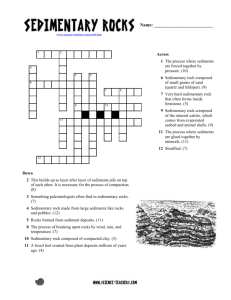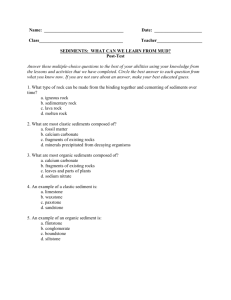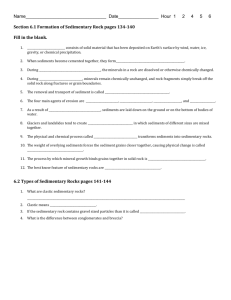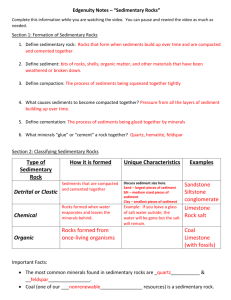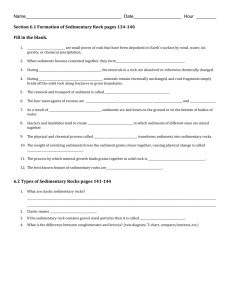Sedimentary Rocks Lab: Processes & Environments
advertisement
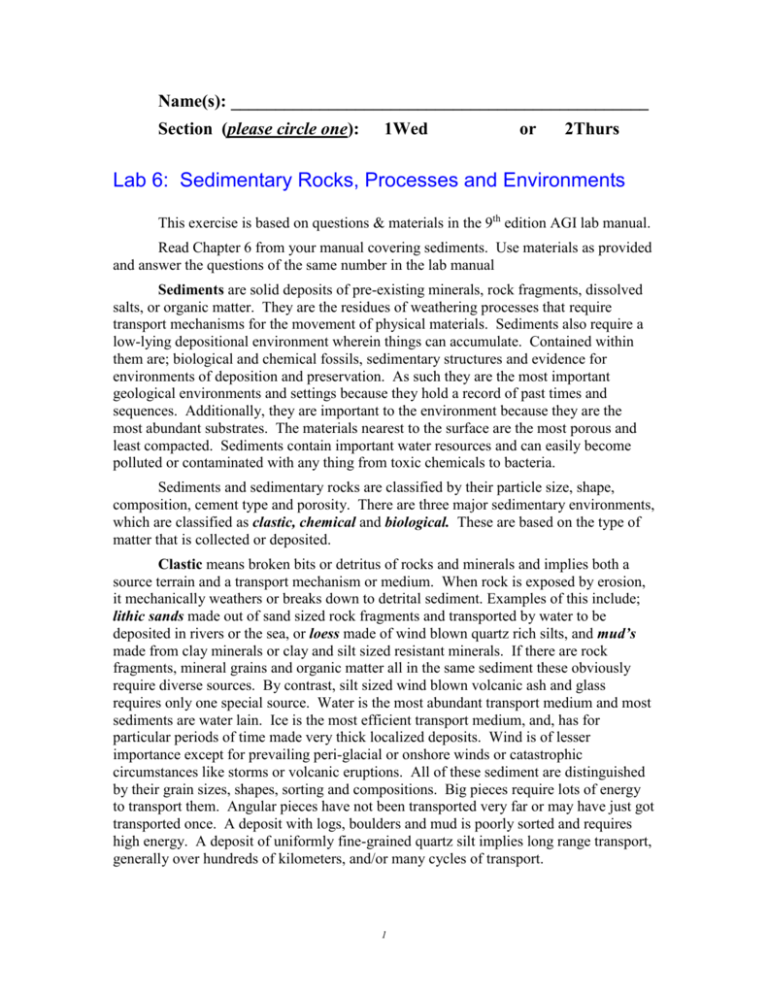
Name(s): _______________________________________________ Section (please circle one): 1Wed or 2Thurs Lab 6: Sedimentary Rocks, Processes and Environments This exercise is based on questions & materials in the 9th edition AGI lab manual. Read Chapter 6 from your manual covering sediments. Use materials as provided and answer the questions of the same number in the lab manual Sediments are solid deposits of pre-existing minerals, rock fragments, dissolved salts, or organic matter. They are the residues of weathering processes that require transport mechanisms for the movement of physical materials. Sediments also require a low-lying depositional environment wherein things can accumulate. Contained within them are; biological and chemical fossils, sedimentary structures and evidence for environments of deposition and preservation. As such they are the most important geological environments and settings because they hold a record of past times and sequences. Additionally, they are important to the environment because they are the most abundant substrates. The materials nearest to the surface are the most porous and least compacted. Sediments contain important water resources and can easily become polluted or contaminated with any thing from toxic chemicals to bacteria. Sediments and sedimentary rocks are classified by their particle size, shape, composition, cement type and porosity. There are three major sedimentary environments, which are classified as clastic, chemical and biological. These are based on the type of matter that is collected or deposited. Clastic means broken bits or detritus of rocks and minerals and implies both a source terrain and a transport mechanism or medium. When rock is exposed by erosion, it mechanically weathers or breaks down to detrital sediment. Examples of this include; lithic sands made out of sand sized rock fragments and transported by water to be deposited in rivers or the sea, or loess made of wind blown quartz rich silts, and mud’s made from clay minerals or clay and silt sized resistant minerals. If there are rock fragments, mineral grains and organic matter all in the same sediment these obviously require diverse sources. By contrast, silt sized wind blown volcanic ash and glass requires only one special source. Water is the most abundant transport medium and most sediments are water lain. Ice is the most efficient transport medium, and, has for particular periods of time made very thick localized deposits. Wind is of lesser importance except for prevailing peri-glacial or onshore winds or catastrophic circumstances like storms or volcanic eruptions. All of these sediment are distinguished by their grain sizes, shapes, sorting and compositions. Big pieces require lots of energy to transport them. Angular pieces have not been transported very far or may have just got transported once. A deposit with logs, boulders and mud is poorly sorted and requires high energy. A deposit of uniformly fine-grained quartz silt implies long range transport, generally over hundreds of kilometers, and/or many cycles of transport. 1 The most abundant chemical sediments include limestones precipitated from salty or hyper saline warm tropical shallow waters or travertine from hydrothermal spring waters. Gypsum, halite’s and other evaporate mineral deposits are formed by evaporation in restricted hot basins both in coastal settings and on land. Banded Iron formations were deposited in the Precambrian as the atmosphere and seas came to have free O2 from the appearance of cyanobacteria. Modern oxy-hydroxides of iron and manganese are deposited in bogs, seeps and as deep sea nodules. Sulfide chemical sediments from in reducing or acidic environments from submarine hot springs and dense metalliferrous brines, in bogs and other oxygen poor sediments. Sometimes chert and barite can be exhalative chemical sediments from the discharge of warm submarine springs or nearby volcanoes. Tropical and arid environments are the most favoured for chemical sediments in shallow restricted basins or in playa lakes and salt flats on land. Biological sediments include any material produced exclusively as a product or byproduct of living organisms. This includes: chert from diatoms or radiolarians, chalk and carbonate ooze from foraminifera or other calcareous nanno-fossils, limestone made from marine calcareous animal fragments, phosphate rock mainly from fish fecal pellets, teeth and bones. On land, plants that generate cellulose can accumulate faster than bacteria or fungi can decompose them to make deposits of peat. There are endemic in high latitude marshes and bogs, which are also lacking in oxygen needed for the breakdown. Modern environments, where much organic waste is dumped, also leads to eutrophic conditions and the accumulation of organic matter (outfalls, sewage ponds, landfills). Examples include wet fibrous peat’s, cannel coals and super-hydrous organic slimes such as effluent from abattoirs, pulp mills and sewage outfalls. Organic rich silicate muds and limestone muds (oil shale) are the organic source rocks for major oil and gas deposits. Sediments deposited by a species or by an assemblage of fossil and microfossils, record prevailing evidence of where the organisms grew and indicate what the specific prevailing thermal and chemical conditions were at the time. Calcium carbonate (CaCO3) in microfossils preserves both the oxygen and carbon stable-isotopic records of water sources and temperatures. This information can be used to give a paleo-record of environmental changes with time. Even organic molecules like hormones and porphyrins, unique to life and biosynthesis make chemical trace fossils of past life and past environments in sediments. Sediments can be dated by a number of physical means depending on their age and composition. For materials that have modern carbon as wood or shells dates can be obtained on sediment younger than 60,000 years a by the 14C method. Minerals can make good chemical, temporal and isotopic tracers to their source areas. An example would be using a particular volcanic glass or feldspar composition as a horizon or event marker. Meteorite impacts leave widespread aerosols of fine particles (tektites) that can be physically and chemically recognized in sediments. Beach sands with plastic and Styrofoam are reworked or deposited in modern time. In Nanaimo Harbour and on Roberts Bank, on the Mainland near the coal port, coal detritus shows up in the sediments when it was first mined and shipped. Below that level there is no coal detritus present. For polluted sediments, the mere presence of pollution marks the onset of that industrial activity or source and thus they can be used for correlation. When lead (Pb) 2 was added to gasoline’s as tetra-ethyl lead anti-knock compounds its’ combustion byproducts ended up in the dust of the world between the 1920’s and 1980’s in North America and Europe and is still present in some places without environmental legislation like the Philippines. Many industrial metals are of this type; Copper (Cu), Zinc (Zn), Lead (Pb), Manganese (replacement for lead, and in steels), Cadmium (Cd), Mercury (Hg) from batteries and various industrial processes appear when the industry or waste appears and persist until the source is discontinued (throwing batteries away, etc.). Radioactive fallout of Cesium (137Cs), Strontium (90Sr) etc. from atmospheric weapons testing is a good horizon marker from 1954 through 1964. Even after the Nuclear Test Ban Treaty this material continues to work its way through the sedimentary system or accumulates from new sources, for example; accidents like Three Mile Island’s leak or Chernobyl’s meltdown. Radioactive Cesium (Cs) is particularly immobile in clayey and peaty sediments up to acidities sufficient to gelatinize and destroy clay mineral structures. Radioactive Strontium (Sr) is immobile in modern lime mud and alkaline lakes. Lead (210 Pb) is a natural background isotope from Radon and the Uranium decay series. It is present at low levels in all sediments and rocks. For sediments older than 200 years, there are only the naturally generated background amounts. For sediments younger than this there is an excess of Lead (210Pb) related to nuclear fallout; radon (Rd) converts to lead and falls out on atmospheric dust. Measuring the changing concentration of these elements over corresponding changes in sediment depths can be used to infer the modern epoch versus pre-industrial background levels. This is important for setting environmental loads and backgrounds. Measuring the sequence of dis-equilibrium isotopes in the Uranium ( U ) and Thallium ( Th ) decay series can be used back to 1.6 Ma in appropriate environments like calcareous sediments and cave formations. Potassium (40K) is good beyond 1.6 Ma in feldspars and volcanic ash deposits. The conclusion is that while not all sediments can be dated analytically, many types and environments can be. Where they occur calibrated environmental studies can be made. Answer questions from Lab 6 in the manual in the spaces provided on this sheet. Activity 6-1: Clastic and Detrital Sediment (use friable, weathered specimens of plutonic, volcanic and clastic rocks provided) Questions A. Obtain a piece of weathered, friable plutonic rock like a granite or diorite, a pyroclastic rock like a volcanic tuff, a metamorphic rock like a schist or marble and a sedimentary rock like a friable sandstone, coquina or a shale from the bin of weathered rocks, your hand lens and a piece of coarse sandpaper (quartz, garnet or corundum). 1. Hold 2 rocks together and gently abrade them over a piece of clean paper until some fragments or grains fall off onto the paper. Save the grains for in a plastic tray for Q3 and determine visually whether they are rock fragments, individual minerals or a mixture of 3 both. Circle which one it is in the line above. Identify the minerals as best you can and list them here: ________________________________________________________. (3) 2. Circle the correct term for the type of sediment you just made: bioclastic , pyroclastic , siliciclastic and explain why this is the correct choice. _______________________ ___________________________________________________________________. (3) 3. Use the grains from Q1 and examine them for angularity-roundedness. Draw the shapes of at least 3 of them here making sure to select ones that represent the total variation in shapes. Describe the grains with the best term from the chart on p 141 and on figure 6.1 p. 129. For this an all other drawings put in a scale bar. Shape name: . (3) Drawing of grains: 4. Feel your grains with your fingertips. Coarse sand and gravel feel gritty. Silt is too small to see the grains but you can feel them rolling over the ridges in your fingerprints. Silt when wetted also rolls into little worms or micro-doobies! Clay slips and smears leaving a film on your fingertips but has no obvious grains. Use the grain size tool in the back of the book and the ruler to describe the grain sizes. Give the grain size range both in mm _______________ and according to the Wentworth scale. Circle the correct term: Gravel Sand Silt Clay . (3) Does your detrital sample had more than one size range ? _______________. Think about the significance of this for sedimentary transport by gravity, water, wind or ice. 5. Find one of your weathered rocks with a sharp corner. Draw this below. Next take a piece of coarse sandpaper and abrade this same corner. Now draw it again next to your first sketch. Describe in words what your abrasion did to the sharp corner. Sketch Before: Sketch After: Abrasion did: ________________________________________________________ (3) 4 6. On the image of the Mississippi River Delta below, Write a capital ” D” on the region with the greatest deposition of detrital (clastic) sediments. (1) B. Sediment is transported under the influence of gravity (rockfalls, landslides) and via fluids such as wind, water or ice. Due to the weight and hardness of sedimentary particles, any transport can erode a channel or abrade the underlying surface. Of thee three transport agents, Ice can carry the greatest range of sizes but is not very discriminating and when ice ages end, its deposits are the thickest in the sedimentary record, > 4 km. Water can transport boulders in debris flows or flash floods, or mud in a lazy river. Wind at its strongest usually moves sand, though in blasts even rocks can be transported this way as when volcanoes erupt violently or when “someone pulls” The World Trade Centre. 1. Scrape a piece of soft shale, mudrock or limestone provided across your sandpaper. Draw the pattern of scratches on the rock and indicate the direction of transport of the “glacial striations” you just made. Draw and label this here: (1) 2. Pretend the surface of your soft rock is the surface of a single sand grain dropped out of a glacier into a meltwater stream. Rub it several different directions with the sandpaper. Use this to realize how rolling sand eventually scratches and abrades. Note the pattern of scratches and draw them here. (2) 5 3. The high energy and impacts experienced by quartz grains frozen into ice then released into turbulent glacial melt water streams tends scratch them with micro striations in various directions and to facet them, taking clear crystalline dings out on all sides. By contrast most water lain sediment is quieter realms is smoothed uniformly on the surface, rounded and polished. Examine the pictures of the polished quartz grains in the moderate and well sorted photos in Figure 6.1 p 129. Wind tends to give the surfaces of sand grains a frosted appearance like bathroom privacy glass, from many small wind powered sand blasting impacts. Because of these different natures of abrasion during transport, the agent or process can often be inferred by measuring and examining individual grain surfaces and the overall characteristics of sand populations. Which one does your shale surface most resemble. Circle it below. angular & faceted subangular & polished rounded & frosted (1) Activity 6-2: Biochemical Sediment and Rock (use seashells, a plastic bag, weighing boats, coquina, encrinal limestone, chalk, chert with matrix, charcoal, and coal provided from our collection) and weighing boats (translucent plastic trays). Questions A. Obtain a hard seashell from our collection. Go down to Q2 and draw it there, then place it in a plastic bag and crush it at the hammering station between 2 wooden blocks. Bring it back and place your fragments into a plastic weighing boat tray for examination. 1. The shell fragments are clasts. Which type are they? Circle the correct type below. bioclastic , pyroclastic , siliciclastic and explain why this is the correct choice. ____________________________________________________________________ ____________________________________________________________________ (3) 2. Compared to Figure 6.1 on page 129, or th inset on p141 describe the shape of your individual clasts. Circle the dominant shape: angular sub-angular sub-rounded rounded Explain how this shape relates to the original shape of your shell and to the amount of “transport or abrasion” it experienced at your tender mercies! ___________________ _____________________________________________________________________ Draw your original shell and one of the fragments you obtained below. (5) 3. Examine the photo in the manual on p 143 of polished shell fragments and find a piece of coquina from our collection. A coquina is a “beach rock” comprised almost entirely of coarse shell fragments. A modern name for this type of coarse limestone is a “biorudite”, meaning shells and angular, coarse grain size. Check the classification chart Figure 6.3 6 on p.131. Compare the coquina to both photos B & C on p.133 and to the photo of loose shell fragments and to your smashed shells. Describe the kind of sedimentary environment, transporting fluid and possible depositional setting using one of the depositional facies locations indicated on figure 6.2 on p 130. Write your interpretation for the photo of the loose shells and for the coquina it could become below, then put a circled “1” on the facies diagram like fig 6.2 on the figure below. _________________ ______________________________________________________________________ ___________________________________________________________________ (2) Estimate the % of porosity = Φ, (void space between the shells). You can do this visually, but can check it by first by taking a plastic weighing boat (small square tray) weighing your coquina dry. The sample weight is mostly shells of calcium carbonate with a density of 2.70 g/mL. Therefore, the volume of shells in the coquina is: Shells mL = (Dry weight)__ g / 2.70 g/mL : Calculate this here________________ (2) Now your coquina in a beaker of water until the bubbles stop and weigh it again. The weight gained is all water at a density of ~1.00 g/mL filling the pore spaces, so the space filled by water is: H20 mL = H20 _(weight gained)_ g / 1.00 g/mL : Calculate this here____________ (2) Now that you have the volume of your sample which is shells and the volume which is water, or voids which can hold water, you can calculate the porosity, or volume % voids like any other percentage calculation: Φ % = 100 x (H20 mL) / (Shells mL + H20 mL) : Calculate this here___________ (2) Explain why it would be a good aquifer or reservoir rock ______________________ ____________________________________________________________________ (2) Sketch the coquina. (5) 4. Examine pieces of chalk and chert with some surrounding matrix from our collection. Both the chalk and the chert should feel smooth and even under a hand lens there are usually no visible grains. This is because they are made with the individual hard, heavy, mineral tests of one celled phytoplankton. While these are present as traces in many sediments, to obtain pure deposits of one or the other requires deep water far offshore. Foraminifera and coccolits tend to live in tropical or subtropical waters, while diatoms and radiolarian prefer cooler boreal or subtropical latitudes. Both occur in deep sea sediments west of Vancouver Island. Write 2 for Chalk and 3 for Chert in a likely depositional environment for each on the figure 6.2 on the following page. Try both your chalk & your chert on a streak plate and note which is harder and circle the harder one: Chalk Chert 7 Test the chalk with hydrochloric acid and explain how you can tell what mineral it is made from. ___________________________________________________________ _____________________________________________________________________ (2) Figure 6.2: Plot: 1 for Coquina, 2 for Chalk, 3 for Chert & A, B, C, D, E, & F see below (6) 5. Based on the grain size, composition, availability of other sediment types and the facies diagram above, explain where Chalk and Chert form, and why they tend to be found there rather than some other adjacent environment ___________________________________________ __________________________________________________________________________ __________________________________________________________________________ (2) B. Obtain some charcoal or charred wood and a piece of coal from our collection. Take the charcoal, place it in a plastic bag and crush it at the hammering station between 2 wooden blocks. Bring it back and place your fragments into a plastic weighing boat tray for examination. Compare this to the piece of coal provided from the Quinsam Mine in the Upper Cretaceous Nanaimo Group west of Campbell River. 1. Examine the charcoal fragments for density, shape and internal structures. How is this different from the wooden block you used at the hammering station. Draw a piece of charcoal and label any biological structures you can see. (2) 8 2. Charcoal is made by burying a pile of burning wood so that is smolders slowly with a lack of abundant oxygen. Under these heated reducing conditions, hydrocarbon molecules outgas and fall apart leaving a carbon rich residue, that like coal might be 75% carbon by weight. Coal is made by burial of cellulose and other organic matter under water and sediment so that there is no free oxygen for bacteria to degrade it and use it for food. In either case, lacking abundant oxygen, the organic matter instead of breaking down to CO2 and H2O, leaves a carbon rich residue and holds it in sediments for geological amounts of time. Burned or charred wood is less bioavailable as a ready food source so many coal fragments in the sedimentary record, began their sedimentary life as particles of charred wood left over from some forest fire. Until plants conquered land, and made abundant forests in Late Devonian, there are no coal deposits in the geological record. Examine your specimen of coal and search for any evidence of compaction or layering. Sometimes there are clay layers or pyrite that contribute to a coal’s ash content and pollution problems as a fuel source as they make toxic metal dust and acid rain. Also examine it under a hand lens or binocular microscope and look for any remnant biological structures or fossils. While these may be present in some coal seams, usually the coal is too recrystallized or organically metamorphosed into other organic compounds. While these are not minerals, we give them mineral like names: fusain for dusty black matter, durain for dull appearing hard blocky matter, vitrain for shiny, glassy appearing coal. When coal is mined underground, powdered limestone dust is wet sprayed on the coal face to cut down on explosive or flammable coal dust. Draw your coal specimen and label as many structures or components as you can see. (3) Activity 6-3: Chemical Sediments and Sedimentary Rocks (use friable or vuggy limonite, oolitic hematite, ferruginous sandstone, halite, sylvite (KCl, no-salt) and massive gypsum or powdered wallboard, mortar and pestle, test tubes & metal holders, Bunsen burner). Questions A. When rock is exposed by erosion, it chemically weathers. Feldspars weather to clays and soluble molecules like H4SiO4 and ionic salts (Na+, Ca+2, K+). Ferromagnesian minerals weather to soluble ions too (Fe2+, Mg2+) but the iron readily oxidizes to Fe3+ and makes insoluble precipitates of iron oxides and hydroxides which colour your world, or at least the rocks and soils! Yellows and reds are more oxidized while greens are reduced. 9 1. Obtain some oolitic hematite. This sample from the Ordovician on Belle Isle, NF is a hematite rich limestone with about 7% Fe, Layering and marine shell fossils in some samples. It was mined for Fe up into WWII. Examine its streak on a light streak plate. Describe it’s colour & smear some of it on the page here for proof of your colour! (4) Sample of streak: ________ Colour: __________ Ion ____ Chemical formula _______ 6. Examine the large red and white specimen of “Potash” ore from a layered Devonian Salt Deposit which is mined below Esterhazy Saskatchewan. Note the red, clear and chalky white crystals in this mixed evaporite deposit. Halite you already know but the rarer bittern salts Sylvite (Grey recessed) and Carnallite (reddish) only form when a sea or marine basin evaporates completely to dryness as the last 1% of the water leaves. These potassium and complex magnesium sulfate-chloride salts are that incredibly soluble. They are our main ores of potassium and magnesium for fertilizers and for magnesium metal. Obtain 2 small weighing boats and sprinkle a pinch of common halite (NaCl) in one and in the other a pinch of “No Salt” sylvite (KCl). Note the shapes of the individual crystals and draw or describe their habits. ______________________________________________________________ (2) Wet your finger and taste, first the ordinary salt and next the sylvite and describe how the tastes are similar and different. Halite:_________________________________________________________________ Sylvite:______________________________________________________________ (2) 7. Obtain specimens of gypsum and anhydrite. Gypsum and anhydrite form from evaporation of hard, sulfate rich waters. There are commercial deposits of these in Nova Scotia on Cape Breton Island which are quarried and used to make wallboard and plaster. Examine these with your hand lens and describe their crystal sizes, shapes and textures. Gypsum:________________________________________________________________ Anhydrite: __________________________________________________________(2) What other physical properties do these minerals have in common with halite and sylvite other than the crystalline textures? ___________________________________(2) How can you tell these are evaporite minerals? _______________________________ _____________________________________________________________________(3) Activity 6-4: Sediment Analysis, Classification and Interpretation: Use the photos of sediment on p 145 and the geo-tools card in the back of your manual. Additionally, obtain a small weighing boat and take a few grains of the ~7700 year old Mazama ash to examine & describe. The texture of sediment is used to interpret its provenance (where it came from), what kind of transport fluid carried it (water, wind, ice), how far 10 it had travelled. Maturity is measured in 2 ways: chemical and mechanical. A high mechanical maturity is when the majority of grains are all the same size (well sorted) and also well rounded, indicating either a great distance or a great number of cycles of transport and deposition, as with sand that rolls up and down the beach with every wave. Chemical maturity is judged by the relative presence of chemically resistant minerals like quartz (both hard and pretty insoluble). Other minerals that increase with maturity are clays, iron and other metal oxides and some tough heavy minerals like: corundum, diamond, garnet , topaz, tourmaline, zircon. By contrast the presence of easily weathered materials like: rock fragments, calcite, feldspars and common ferromagnesian minerals means a low chemical maturity. Questions A. Examine the photo of sample A and figures 6.1 p129 & 6.3 p131 and the roundedness drawings on p141. Note the scale bar on Sediment 6.4A on p145 like you should have in each of your own drawings! This is a lithic sediment (comprised of different types of rock fragments). Make visual estimates of the following using your tables referred to above and your geo tools card in the back of the manual. 1. The grain size range in mm is: from _________ to _________. (2) 2. The % of each grain size class is: Clay ____ 3. Grain sorting (circle best choice): Poor 4. Grain roundedness (circle best choice): 5. Sediment composition (circle): Silt ____ Sand ____ Moderate Gravel ____ (4) Well (1) Angular Sub-Rounded Well-rounded Detrital Biochemical Chemical (1) (1) (Siliciclastic) (or Bioclastic) 6. Describe the process of transport and deposition _____________________________ _____________________________________________________________________ (2) 7. Select the best environment putting an “A” on Figure 6.2 above for its likely origin. 11 C. Examine the photo of sample C. This is mostly comprised of faceted to frosted quartz with a few black chert grains. Make visual estimates of the following as above. 1. The grain size range in mm is: from _________ to _________. (2) 2. The % of each grain size class is: Clay ____ 3. Grain sorting (circle best choice): Poor 4. Grain roundedness (circle best choice): 5. Sediment composition (circle): Silt ____ Sand ____ Moderate Gravel ____ (4) Well (1) Angular Sub-Rounded Well-rounded Detrital Biochemical (1) Chemical (1) (Siliciclastic) (or Bioclastic) 6. Describe the process of transport and deposition _____________________________ _____________________________________________________________________ (2) 7. Select the best environment putting an “C” on Figure 6.2 above for its likely origin. Examine the photo of sample D. This is mostly comprised of concentrically rounded ooids (oolites) of calcium carbonate. Make visual estimates of the following as above. 1. The grain size range in mm is: from _________ to _________. (2) 2. The % of each grain size class is: Clay ____ 3. Grain sorting (circle best choice): Poor 4. Grain roundedness (circle best choice): 5. Sediment composition (circle): Silt ____ Sand ____ Moderate Gravel ____ (4) Well (1) Angular Sub-Rounded Well-rounded Detrital Biochemical Chemical (1) (1) (Siliciclastic) (or Bioclastic) 6. Describe the process of transport and deposition _____________________________ _____________________________________________________________________ (2) 7. Select the best environment putting an “D” on Figure 6.2 above for its likely origin. 12 Examine the photo of sample E. This is mostly comprised of shelly debris of small gastropods built from calcium carbonate. Make visual estimates of the following. 1. The grain size range in mm is: from _________ to _________. (2) 2. The % of each grain size class is: Clay ____ 3. Grain sorting (circle best choice): Poor 4. Grain roundedness (circle best choice): 5. Sediment composition (circle): Silt ____ Sand ____ Moderate Gravel ____ (4) Well (1) Angular Sub-Rounded Well-rounded Detrital Biochemical (1) Chemical (1) (Siliciclastic) (or Bioclastic) 6. Describe the process of transport and deposition _____________________________ _____________________________________________________________________ (2) 7. Select the best environment putting an “E” on Figure 6.2 above for its likely origin. Examine your sample of Mazama ash, sample G. This is ~ 7700 BP eruption of Mt. Mazama from the caldera collapse event that formed Crater Lake, OR. The sample was transported by wind, deposited on snow, and redeposited in a collected from a 10 m thick section massive section deposited in a landslide dammed lake in upper Skagit Valley, south of Bellingham WA. It is almost entirely volcanic glass with a few phenocrysts. Make visual estimates of the following as above. 1. The grain size range in mm is: from _________ to _________. (2) 2. The % of each grain size class is: Clay ____ 3. Grain sorting (circle best choice): Poor 4. Grain roundedness (circle best choice): 5. Sediment composition (circle): Silt ____ Sand ____ Moderate Gravel ____ (4) Well Angular Sub-Rounded Well-rounded Detrital Biochemical Chemical (1) (1) (1) (Siliciclastic) (or Bioclastic) 6. Describe the process of transport and deposition _____________________________ _____________________________________________________________________ (2) 7. Select the best environment putting an “G” on Figure 6.2 above for its likely origin. At this point you should have 10 different letters and numbers for the different facies locations of sediments you described on figure 6.2. 13 Activity 6-6: Outcrop Analyses and Interpretation. Refer to p 151. A. Mississippian Age, Calcarenites of the Mauch Chunk Formation from Pennsylvania. Read about Calcarenites in Figure 6.3, then examine Figure 6.10 on p 138 then answer the following: 1. Note the dip (inclination) for the upper darker coloured beds and also the dip for the lighter coloured lower beds in front of the 2 people. a. The current that deposited the upper beds was flowing to the (circle) Left Right (1) b. The current that deposited the lower beds was flowing to the (circle) Left Right (1) 2. What is the name of this type of sedimentary structure from your choices in Fig 6.10? ____________________________________________________________________ (1) 3. Refer to figure 6.2 again. Compared to modern marine environments and places where limestones can form, what sort of environment could give rise to sediments this coarse, of this composition and with different transport directions? ________________________ ____________________________________________________________________ (2) 4. This part of Pennsylvania is now on land in the Appalachian Mountains with a climate like the Northeastern USA. Describe in words what this environment was like at the time these calcarenties were deposited.______________________________________ ____________________________________________________________________ (2) Activity 6-7: Using the present to visualize the past: Part 1, Triassic of Pennsylvania. Examine the photos on p 152 and see our sample of a slab of “redbed” rock from a similar setting. Refer to the sedimentary structures Figure 6.10 on p 138 & 139. A. How are the modern environment pictured on the left and the Triassic one pictured on the right, the same? _____________________________________________________ _____________________________________________________________________ (2) B. How are the modern environment pictured on the left and the Triassic one pictured on the right, different? ______________________________________________ _____________________________________________________________________ (2) C. Describe the sedimentary environment and Triassic ecosystem including: land or water, vegetation, organisms and climate. _____________________________________ _____________________________________________________________________ _____________________________________________________________________ _____________________________________________________________________ (4) 14 Activity 6-8: Look at p. 153, Using the present to visualize the past: Part 2. Kansas in the Pennsylvanian Period. Refer to figure 6.3 for Calcarenite & the sedimentary structures Figure 6.10 p 138 & 139. A. Examine the thin section of Pennsylvanian (290 Ma) calcarenite fiewed in plane polarized light and the top view of a bedding plane showing fossils (of animals or portions thereof) and trace fossils (of animal behaviour). Keep in mind what kind of mineral(s) which make up this sediment. Fossils are per-mineralized replacements of once living tissues. Trace fossils are trails and tracks made by feet, bodies, tails as animals moved about. Note the nickel coin for scale. B. This photo is of the modern seabed off of Cape Cod Massachusetts in 40 m of water depth. You can just swim in these waters in summertime due to the Gulf Stream, but Boston gets some wicked winter snow storms right next door on land. From the description and setting off the eastern seaboard, this is a well sorted siliciclastic sand. 1. How are the modern environment pictured (photo B, Cape Cod) and the Pennsylvanian one (photo A, Kansas) the same? ____________________________ _____________________________________________________________________ (2) 2. How are the modern environment pictured (photo B, Cape Cod) and the Pennsylvanian one (photo A, Kansas) different? ____________________________ _____________________________________________________________________ (2) 3. Today this part of Kansas is flat prairie farmland. Describe the sedimentary environment and Pennsylvanian ecosystem in Kansas including: land or water, vegetation, organisms and climate. _______________________________________ ______________________________________________________________________ _____________________________________________________________________ (4) Activity 6-9: Stratigraphy: Reading Earth History and sea Level Changes from a sequence of sedimentary beds. There are paired photos for each level of strata. One is a sidelong view of the bedding and weathering character of the sedimentary rocks. The next one is a plan view looking down onto a bedding plane, showing sedimentary structures or fossils. Each pair of rock photos has general descriptions of the materials present. Use your tables for sedimentary rock identification, grain sizes, sedimentary structures and the facies diagram 6.2 to come up with a short (1 to 5 word) description of the overall environment or setting that the sediments were deposited in. Then simplify this interpretation even further to place a single x in the best choice for an environment or facies. See the examples for the lowest 2 strata. Complete the figure provided. (9) 15 Activity 6.5: Interpretation Hand Sample and Thin Section Analysis & Complete the Sedimentary Rocks Worksheet 16 (Activity 6-5: Sedimentary rocks worksheet for hand specimens placed at end of lab.) Describe 5 hand specimens from the following labeled specimens on large trays: ACalcirudite or B-Dolostone, C-Siltstone or D- Greywacke, E-Arkose or F-Ferruginous Sandstone, G-Pebble conglomerate, H- fossiliferous limestone/encrinal limestone and IBituminous sandstone or J-oil shale by filling out the table provided. 17 Activity 6-10: Draw and label 3 thin sections including: Be sure to include a scale bar for each drawing and label any minerals, sedimentary structures or fossils present. (15) Sandstone: Name:___________ Sample # ________________ Encrinal limestone: Sample # ________________ Oolitic limestone or phosphate rock: Sample # ________________ 18




